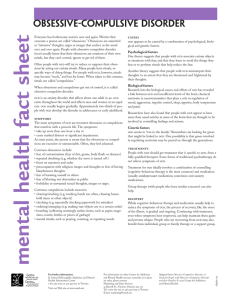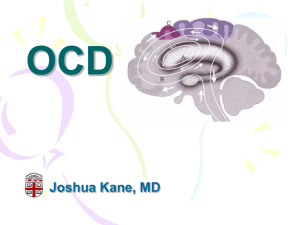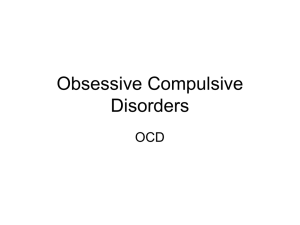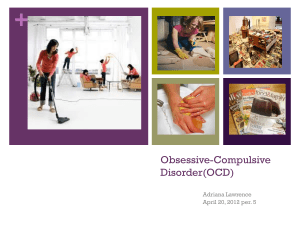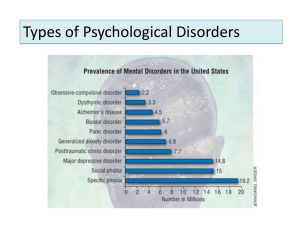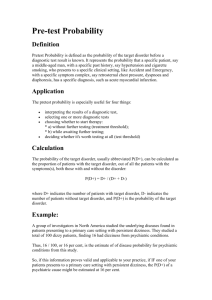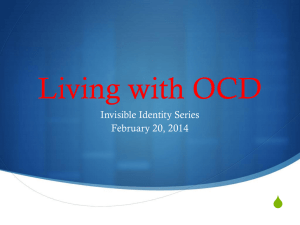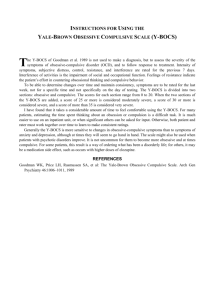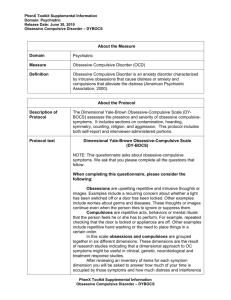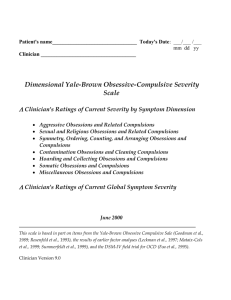OCD diagnosis & prevalence
advertisement
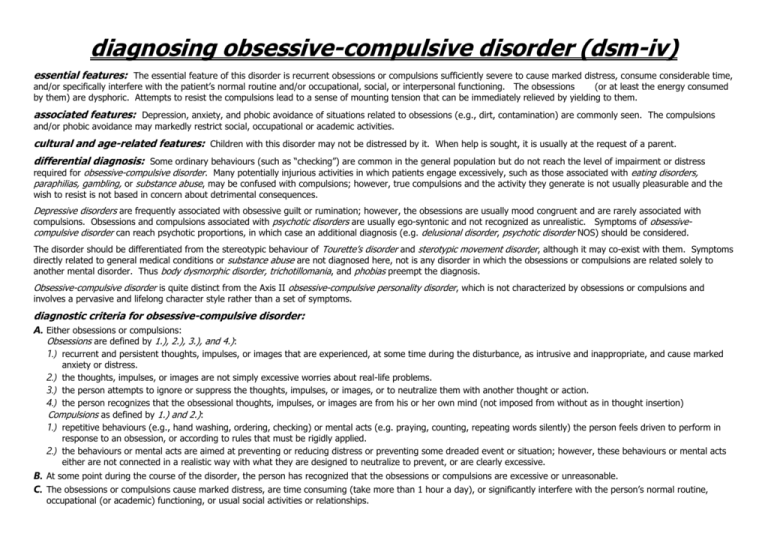
diagnosing obsessive-compulsive disorder (dsm-iv) essential features: The essential feature of this disorder is recurrent obsessions or compulsions sufficiently severe to cause marked distress, consume considerable time, and/or specifically interfere with the patient’s normal routine and/or occupational, social, or interpersonal functioning. The obsessions (or at least the energy consumed by them) are dysphoric. Attempts to resist the compulsions lead to a sense of mounting tension that can be immediately relieved by yielding to them. associated features: Depression, anxiety, and phobic avoidance of situations related to obsessions (e.g., dirt, contamination) are commonly seen. The compulsions and/or phobic avoidance may markedly restrict social, occupational or academic activities. cultural and age-related features: Children with this disorder may not be distressed by it. When help is sought, it is usually at the request of a parent. differential diagnosis: Some ordinary behaviours (such as “checking”) are common in the general population but do not reach the level of impairment or distress required for obsessive-compulsive disorder. Many potentially injurious activities in which patients engage excessively, such as those associated with eating disorders, paraphilias, gambling, or substance abuse, may be confused with compulsions; however, true compulsions and the activity they generate is not usually pleasurable and the wish to resist is not based in concern about detrimental consequences. Depressive disorders are frequently associated with obsessive guilt or rumination; however, the obsessions are usually mood congruent and are rarely associated with compulsions. Obsessions and compulsions associated with psychotic disorders are usually ego-syntonic and not recognized as unrealistic. Symptoms of obsessivecompulsive disorder can reach psychotic proportions, in which case an additional diagnosis (e.g. delusional disorder, psychotic disorder NOS) should be considered. The disorder should be differentiated from the stereotypic behaviour of Tourette’s disorder and sterotypic movement disorder, although it may co-exist with them. Symptoms directly related to general medical conditions or substance abuse are not diagnosed here, not is any disorder in which the obsessions or compulsions are related solely to another mental disorder. Thus body dysmorphic disorder, trichotillomania, and phobias preempt the diagnosis. Obsessive-compulsive disorder is quite distinct from the Axis II obsessive-compulsive personality disorder, which is not characterized by obsessions or compulsions and involves a pervasive and lifelong character style rather than a set of symptoms. diagnostic criteria for obsessive-compulsive disorder: A. Either obsessions or compulsions: Obsessions are defined by 1.), 2.), 3.), and 4.): 1.) recurrent and persistent thoughts, impulses, or images that are experienced, at some time during the disturbance, as intrusive and inappropriate, and cause marked anxiety or distress. 2.) the thoughts, impulses, or images are not simply excessive worries about real-life problems. 3.) the person attempts to ignore or suppress the thoughts, impulses, or images, or to neutralize them with another thought or action. 4.) the person recognizes that the obsessional thoughts, impulses, or images are from his or her own mind (not imposed from without as in thought insertion) Compulsions as defined by 1.) and 2.): 1.) repetitive behaviours (e.g., hand washing, ordering, checking) or mental acts (e.g. praying, counting, repeating words silently) the person feels driven to perform in response to an obsession, or according to rules that must be rigidly applied. 2.) the behaviours or mental acts are aimed at preventing or reducing distress or preventing some dreaded event or situation; however, these behaviours or mental acts either are not connected in a realistic way with what they are designed to neutralize to prevent, or are clearly excessive. B. At some point during the course of the disorder, the person has recognized that the obsessions or compulsions are excessive or unreasonable. C. The obsessions or compulsions cause marked distress, are time consuming (take more than 1 hour a day), or significantly interfere with the person’s normal routine, occupational (or academic) functioning, or usual social activities or relationships. [cont.] D. If another Axis I disorder is present, the content of the obsessions or compulsions is not restricted to it (e.g. preoccupation with food in the presence of an eating disorder; hair pulling in the presence of trichotillomania; concern with appearance in the presence of body dysmorphic disorder; preoccupation with drugs in the presence of a substance use disorder; preoccupation with having a serious illness in the presence of hypochondriasis; preoccupation with sexual urges or fantasies in the presence of a paraphilia; or guilty ruminations in the presence of major depressive disorder). E. The disturbance is not due to the direct physiological effects of a substance (e.g., a drug of abuse, a medication) or a general medical condition. specify if with poor insight: If for most of the time during the current episode, the person dose not recognize that the obsessions and compulsions are excessive or unreasonable. obsessive-compulsive disorder: background facts 1 to 2% of the population suffer from full or sub-clinical obsessive-compulsive disorder (Regier, Narrow et al. 1990; Stein, Forde et al. 1997) Regier, D. A., Narrow, W. E., et al. (1990). "The epidemiology of anxiety disorders: the Epidemiologic Catchment Area (ECA) experience." J Psychiatr Res 24 Suppl 2: 3-14. According to the Epidemiologic Catchment Area (ECA) study--one of the largest investigations of the prevalence of mental disorders ever conducted--anxiety disorders affect more than 7% of adults in the United States. Women, individuals under age 45, those who are separated or divorced, and those in low socioeconomic groups all have a higher rate of anxiety than individuals in other groups. This article will present prevalence rates of anxiety disorders based on data from the five ECA sites--New Haven, Conn; Baltimore, Md; St Louis, Mo; Durham, NC; and Los Angeles, Ca. The one month prevalence rate for any anxiety disorder was 7.3%, for any phobia 6.2%, for panic disorder 0.5%, and for obsessive-compulsive disorder 1.3%. Stein, M., Forde, D., et al. (1997). "Obsessive-compulsive disorder in the community: an epidemiologic survey with clinical reappraisal." Am J Psychiatry 154(8): 1120-1126. OBJECTIVE: To examine the prevalence of obsessive-compulsive symptoms and DSM-IV obsessive-compulsive disorder (OCD), the authors conducted a telephone survey of 2,261 adults in four regions of Canada. METHOD: Trained lay interviewers administered a modified version of the OCD section of the Comprehensive International Diagnostic Interview. A subsample of respondents with probable cases and probable subclinical cases of OCD was then blindly reinterviewed by research personnel experienced in the assessment of OCD, using the Structured Clinical Interview for DSM-IV and the Yale-Brown Obsessive Compulsive Scale, to confirm the diagnosis and gauge the severity of OCD. RESULTS: The weighted 1-month prevalence of OCD in the entire sample according to the lay interviews was 3.1%. Upon clinical reappraisal, the 1-month prevalence estimate of OCD dropped to 0.6%; an additional 0.6% had subclinical OCD. The mean Yale-Brown Obsessive Compulsive Scale score of the individuals with OCD was 19.0 (SD = 4.6, median = 21); for those with subclinical OCD, the mean score was 15.4 (SD = 2.4, median = 14). Common reasons for overdiagnosis of OCD by the lay interviewers were inappropriate labeling of worries or concerns as obsessions and overestimating the degree of interference or distress attributable to obsessive-compulsive symptoms. CONCLUSIONS: OCD, while hardly a rare condition, may be somewhat less prevalent than had been believed on the basis of previous surveys. Additional studies are needed to substantiate these findings and to delineate precisely the extent of disability and reduced quality of life attributable to OCD (and OCD variants) in the community.

